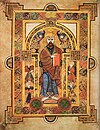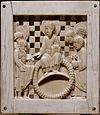Wikipedia:Today's featured article/September 12, 2013
The Middle Ages of European history lasted from the 5th to the 15th century. It began with the collapse of the Western Roman Empire and the subsequent formation of new kingdoms by barbarian invaders. The Franks, under the Carolingian dynasty, established an empire covering much of Western Europe; the Carolingian Empire endured until the 9th century. During the High Middle Ages, which began after AD 1000, the population of Europe increased as technological and agricultural innovations allowed trade to flourish and crop yields to increase. Western European Christians attempted to regain control of the Holy Land in the Crusades. Intellectual life was marked by scholasticism and the founding of universities. The philosophy of Thomas Aquinas, the paintings of Giotto, the poetry of Dante and Chaucer, the travels of Marco Polo, and the architecture of Gothic cathedrals are among the outstanding achievements of this period. The Late Middle Ages was marked by famine, plague, and war; between 1347 and 1350, the Black Death killed about a third of Europeans. Cultural and technological developments transformed European society, leading to the early modern period. (Full article...)
Recently featured: Harry McNish – Pigeye shark – Tasha Yar
Images used in this blurb:
This list of images only shows on this subpage and will not show up on the main page, for example. DO NOT remove the "noinclude" tags!





